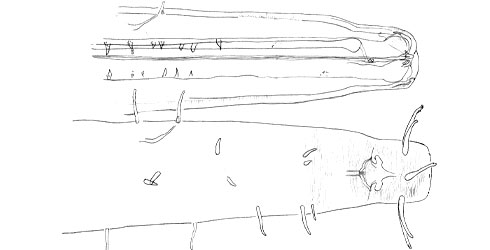Distribution
Like many nematodes, Platycoma sudafricana appears to have a very restricted distribution, yet equally like most nematode genera, Platycoma are found around the world.
Platycoma sudafricana has been formally recorded in one location - the swash zone on a beach in Durban, South Africa. We have now also potentially found it on the high intertidal zone on Inhaca Island, Mozambique.
Studying nematodes is a new and rare science, mainly because they are small and difficult to see, and impossible to identify without microscopes. This means that the currently known distribution of this species (the south east coast of Africa) may be a big underestimate.
The life cycle and behaviour of nematodes, however, means that it is unlikely they disperse far and it is possible this is an isolated population.
Larger nematode species tend to be described first - Platycoma sudafricana was first described in 1966, along with 9 other similarly sized animals. These ‘large’ nematode species, however, tend to represent less than 5% of nematode individuals in any 1 place.
When we recently studied nematode species on beaches in Mozambique and South Africa, we were delighted to find what we think is Platycoma sudafricana - but it was 1 of only 4 nematode species that could be tentatively identified to a known species from the 87 different species we found.
We must understand the relationships between species to understand our environment, so now we take great care to distinguish and identify all species, even those less than half a millimetre long.
Read more about nematodes and their biology in the Manunema kithara species of the day section.
Habitat
Platycoma sudafricana belongs to a family of genera that are found infrequently, and often on sandy beaches.
They are so small that an individual will have a close relationship with a single grain of sand.
Platycoma sudafricana was first found in the swash zone of a beach - this is the lowest point on a beach, is continually wet and maintains approximately the same salinity as the sea.
We now think we have also found it in the high intertidal zone on a beach, which is furthest from the sea. This area is dry most of the time, can get very hot, and varies in salinity - if water evaporates it can be very salty and when it rains it can become almost freshwater (like a lake or stream).
This suggests Platycoma sudafricana can live in extreme conditions, or that it is able to burrow deep into the sand to avoid them.
Little is known about nematode behaviour and life history traits, simply because their size makes them difficult, and expensive, to study. We are still unsure whether we are looking at:
- different species
- species ‘populations’
- one species that is adapted to extreme conditions
